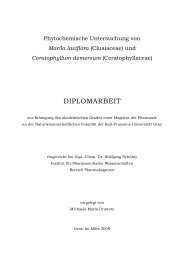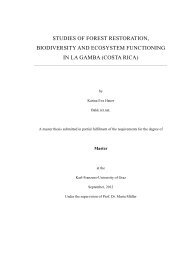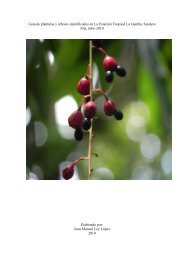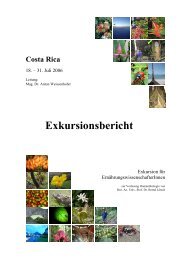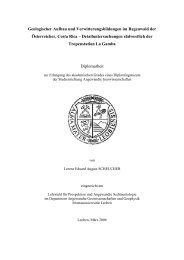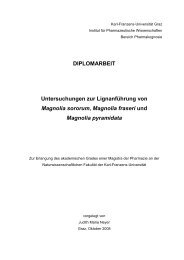Leaf colour patterns, vegetative and sexual reproduction of Episcia ...
Leaf colour patterns, vegetative and sexual reproduction of Episcia ...
Leaf colour patterns, vegetative and sexual reproduction of Episcia ...
You also want an ePaper? Increase the reach of your titles
YUMPU automatically turns print PDFs into web optimized ePapers that Google loves.
An analysis <strong>of</strong> the corolla’s capability to reflect UV-light that was conducted using cobalt blue<br />
glass showed that the whole limb area except the entry reflects UV-light (Fig. 25).<br />
Figure 25. <strong>Episcia</strong> lilacina; photos <strong>of</strong> one flower taken through cobalt blue<br />
glass, the tube entrance absorbs UV.<br />
Discussion: Wiehler (1978) describes the flower <strong>of</strong> <strong>Episcia</strong> lilacina as the only psychophilous<br />
one within the genus <strong>of</strong> <strong>Episcia</strong>. As previously mentioned the legitimate pollinator could not yet<br />
be determined. Nevertheless, the analysis <strong>of</strong> the <strong>Episcia</strong> lilacina’s morphological characteristics<br />
allows to draw conclusions concerning this matter.<br />
Because <strong>of</strong> the long tube <strong>and</strong> the narrow entrance the general access to the floral centre is<br />
impeded in such a way that only certain groups <strong>of</strong> potential pollinators may reach nectar. The<br />
special shape <strong>of</strong> the keyhole flower <strong>of</strong> <strong>Episcia</strong> lilacina implies that the pollinators have to be insects<br />
featuring long proboscises to get access to the nectar in the spur. Firstly the tube does not<br />
proceed straight but is curved. Furthermore, the stamina <strong>and</strong> style impose an impediment. Thus a<br />
pollinator’s proboscis has to pass through the curved tube past filaments <strong>and</strong> style to reach the<br />
nectar in the spur.<br />
In addition, the shape <strong>of</strong> the flower <strong>of</strong> <strong>Episcia</strong> lilacina <strong>of</strong>fers hints on its legitimate pollinator.<br />
Flowers with a narrow tube <strong>and</strong> flat rim are typical for a psychophilous syndrome (Proctor et al<br />
1996, Endress 1994). The keyhole flower represents an increase <strong>of</strong> this principle.<br />
A limb formed by the corolla lobes attracts pollinators <strong>and</strong> serves as a l<strong>and</strong>ing area for<br />
visitors (Westerkamp 1999, Endress 1994, Scoble 1995). The legitimate pollinator is likely to be a<br />
species <strong>of</strong> insects that uses this l<strong>and</strong>ing platform like e.g. Hymnoptera <strong>and</strong> Lepidoptera species.<br />
Hawkmoths (Sphingidae) are able to hover in midair directly in front <strong>of</strong> the flower (Dreisig 1997)<br />
51



